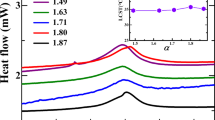Abstract
The formation of chain structures by polarized polyaniline (PANI) particles suspended in silicone oil in the electric field has been monitored by recording suspension conductivity in the course of time. For that purpose, three types of PANI particles differing in the conductivity (3.1 × 10−3, 1.7 × 10−1, and 2.0 × 10−1 S cm−1) have been chosen out of a series of nine samples prepared by controlled protonation of PANI base in orthophosphoric acid solutions. Relaxation times reflecting this process and characterizing the rate of the response to the electric field decreased with particle conductivity, indicating a higher polarizability of particles. At the same time, the maximum conductivity of suspension increased as a consequence of the electric and shear forces acting on the particles. In the shear fields, shorter relaxation times appeared than at rest. The simultaneous measurement of the shear stress confirmed that the conductivity investigation can reliably characterize the development of electrorheological structures.













Similar content being viewed by others
References
Winslow WM (1947) US Patent 2,417,850
Block H, Kelly JP (1988) Electro-rheology. J Phys D Appl Phys 21:1661–1677
Jordan TC, Shaw MT (1989) Electrorheology. IEEE Trans Electron Insul 24:849–878
Block H, Kelly JP, Qin A, Watson T (1990) Materials and mechanisms in electrorheology. Langmuir 6:6–14
Parthasarathy M, Klingenberg DJ (1996) Electrorheology: mechanisms and models. Mater Sci Eng R 17:57–103
Hao T (2001) Electrorheological fluids. Adv Mater 13:1847–1857
Hao T (2002) Electrorheological suspensions. Adv Colloid Interface Sci 97:1–35
Quadrat O, Stejskal J (2006) Polyaniline in electrorheology. J Ind Eng Chem 12:352–361
Choi HJ, Lee JH, Cho MS, Jhon MS (1999) Electrorheological characterization of semiconducting polyaniline suspension. Polym Eng Sci 39:493–499
Lengálová A, Pavlínek V, Sáha P, Quadrat O, Kitano T, Stejskal J (2003) Influence of particle concentration on the electrorheological efficiency of polyaniline suspensions. Eur Polym J 39:641–645
Pavlínek V, Sáha P, Kitano T, Stejskal J, Quadrat O (2005) The effect of polyaniline layer deposited on silica particles on electrorheological and dielectric properties of their silicone-oil suspensions. Physica A 353:21–28
Sung JH, Cho MS, Choi HJ, Jhon MS (2004) Electrorheology of semiconducting polymers. J Ind Eng Chem 10:1217–1229
Stejskal J, Kratochvíl P, Jenkins AD (1996) The formation of polyaniline and the nature of its structures. Polymer 37:367–369
Hong CH, Choi HJ (2007) Shear stress and dielectric analysis of H3PO4 doped polyaniline based electrorheological fluid. J Macromol Sci B Phys 46:683–692
Choi HJ, Cho MS, To K (1998) Electrorheological and dielectric characteristics of semiconducting polyaniline–silicone oil suspensions. Physica A 254:272–279
Chaudhari HK, Kelkar DS (1997) Investigation of structure and electrical conductivity in doped polyaniline. Polym Int 42:380–384
Quadrat O, Stejskal J, Kratochvíl P, Klason C, McQueen D, Kubát J, Sáha P (1998) Electrical properties of polyaniline suspensions. Synth Met 97:37–42
Stejskal J, Gilbert RG (2002) Polyaniline. Preparation of a conducting polymer (IUPAC technical report). Pure Appl Chem 74:857–867
Blinova NV, Stejskal J, Trchová M, Prokeš J (2008) Control of polyaniline conductivity and contact angles by partial protonation. Polym Int 57:66–69
Klingenberg DJ, van Swol F, Zukoski CF IV (1991) The small shear rate response of electrorheological suspensions. 1. Simulation in the point-dipole limit. J Chem Phys 94:6160–6169
Marshall L, Zukoski CF IV, Goodwin JW (1989) Effects of electric fields on the rheology of non-aqueous concentrated suspensions. J Chem Soc Faraday Trans 85:2785–2795
Wu CW, Conrad H (1997) Dielectric and conduction effects in non-ohmic electrorheological fluids. Phys Rev E 56:5789–5797
Lee JH, Cho MS, Choi HJ, Jhon MS (1999) Effect of polymerization temperature on polyaniline based electrorheological suspensions. Colloid Polym Sci 277:73–76
Cho MS, Cho YH, Choi HJ, Jhon MS (2003) Synthesis and electrorheological characteristics of polyaniline-coated poly(methyl methacrylate) microsphere: size effect. Langmuir 19:5875–5881
Acknowledgment
The authors thank the Ministry of Education, Youth and Sports of the Czech Republic (MSM—7088352101) and the Grant Agency of the Czech Republic (202/06/0419) for financial support.
Author information
Authors and Affiliations
Corresponding author
Rights and permissions
About this article
Cite this article
Stěnička, M., Pavlínek, V., Sáha, P. et al. Conductivity of flowing polyaniline suspensions in electric field. Colloid Polym Sci 286, 1403–1409 (2008). https://doi.org/10.1007/s00396-008-1910-2
Received:
Revised:
Accepted:
Published:
Issue Date:
DOI: https://doi.org/10.1007/s00396-008-1910-2




